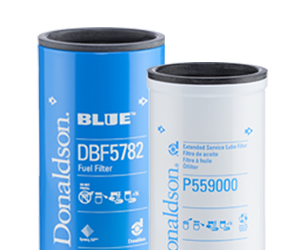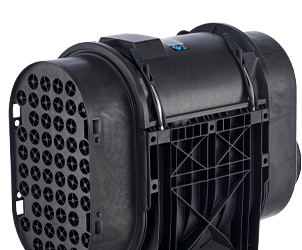Overview
Since Transforming the Hydraulic Media Market Decades Ago, Donaldson Has Continued To Design Media That Exceeds Expectations
When we say Donaldson is the industry leader of media technology, we mean it. Donaldson was the first company to introduce fully synthetic media to the hydraulic market in the early 1980s, and this media is now commonly adopted for extended life and/or enhanced hydraulic system protection needs. Since that first industry-changing media was launched, Donaldson engineers have continued to develop media technology that exceeds application fluid cleanliness and service life expectations. We now have a variety of hydraulic filter media options available to meet the most stringent hydraulic system design requirements.
Filtration Development, Testing, and Analysis
While many of these media varieties have been tested and proven over time, we know that heavy-duty equipment specifications are constantly increasing. We understand that our clients have evolving filter and media needs, which is why we’re constantly pressing forward with new and improved media formulations to meet specific customer requirements.
Our in-house team of scientists and engineers, located around the world, continually develop and refine media options that meet specific customer application and industry needs. In addition to the iterative and incremental improvements, this team is also focused on developing new-to-the-world technologies that achieve even higher levels of performance, which will become the future “standards.”
Features
Our Broad Range of Media Technology Means That You Can Find the Perfect, High-Performing Media for Your Specific Hydraulic System
Every hydraulic filter application has a different job to do, and the oil filtration system for that application should be built to match that job. That’s why Donaldson offers a range of industry-leading media options to meet the particular needs and expectations of your hydraulic applications. All options can be configured to meet specific application and micron-rating requirements.

With the 2021 industry ratification of ISO 23369, lab testing for hydraulic filtration more closely replicates the varying, or “cyclic” flow rates of real-world filter working conditions. This evolution of hydraulic filtration test standards has opened the door for new technology solutions. Alpha-Web media is that new technology solution. The fine-fiber layer of Alpha-Web media enables high filtration efficiency during cyclic flow conditions while minimizing dynamic events where particles are dislodged as the fluid flow changes. Alpha-Web delivers transformational improvement in hydraulic equipment protection.
DT Synteq™ Synthetic Media

Many of today’s hydraulic systems and fluids require enhanced chemicals or thermal compatibilities, like fire resistance, biodegradability, and electrical insulating ability. Donaldson high-performance DT synthetic media can be a highly effective solution for many of these challenges and is ideal for use with phosphate ester and water-glycol fluids.
DT synthetic media grades use a blend of borosilicate glass fiber whose matrix is bonded together with an epoxy-based resin. Donaldson filter media scientists have found that this approach offers a highly effective solution for chemical resistance for a broad array of hydraulic applications.
Synteq XP™ Synthetic Media

Donaldson hydraulic filters with Synteq XP media offer extremely high levels of contaminant capture. This groundbreaking filter media takes hydraulic filtration performance to a higher level by providing enhanced system component protection options. These options include higher efficiency contaminant capture for optimal protection or extended filter life (up to three times that of traditional filter media). Synteq XP media also offers pressure drop that is consistently lower than most competitors, which allows more oil flow during cold start, with reduced reliance on bypass. It also results in greater system efficiency, less energy loss, and extended filter life.
Synteq™ Synthetic Media

Synteq media with predictable filtration efficiencies removes specified contaminants and maximizes dirt-holding capacity. The synthetic fibers are smooth, rounded, and provide low resistance to flow. Their consistent shape allows for control of the fiber size and distribution pattern throughout the media mat to create the smoothest, least inhibited fluid flow. Consistency of fiber shape allows the maximum amount of contaminant-catching surface area and specific pore size control. The low resistance of synthetic media to fluid flow makes it ideal for use with synthetic fluids, water glycols, water/oil emulsions, high water content fluids (HWCF), and petroleum-based fluids.
Cellulose Media

The fibers in cellulose media are actually wood fibers, microscopic in size, irregular in shape and size, and held together by resin. Cellulose often has lower beta ratings, which means there are smaller pores in the media that cause more flow resistance and result in higher pressure drops. While cellulose provides effective filtration for a wide variety of petroleum-based fluids, in certain applications it delivers poorer filtration performance compared to synthetic media.
Water-Absorbing Media

Water-absorbing media quickly and effectively removes free water from hydraulic systems. Using super-absorbent polymer technology with a high affinity for water absorption, this media alleviates many of the problems associated with water contamination found in petroleum-based fluids.
Wire-Mesh Media

Wire mesh media consists of stainless steel, epoxy-coated wire mesh, available in multiple grades. Typically, wire-mesh filters are applied to catch very large, harsh particulate that would damage a normal filter. You may also find this media useful as a coarse filter in viscous fluid applications.
Articles
Resources
Videos

Donaldson Alpha-Web™ Hydraulic Filtration
Alpha-Web hydraulic media enables high filtration efficiency in real-world, cyclic flow operating conditions while minimizing dynamic events where particles are dislodged as the fluid flow changes.






